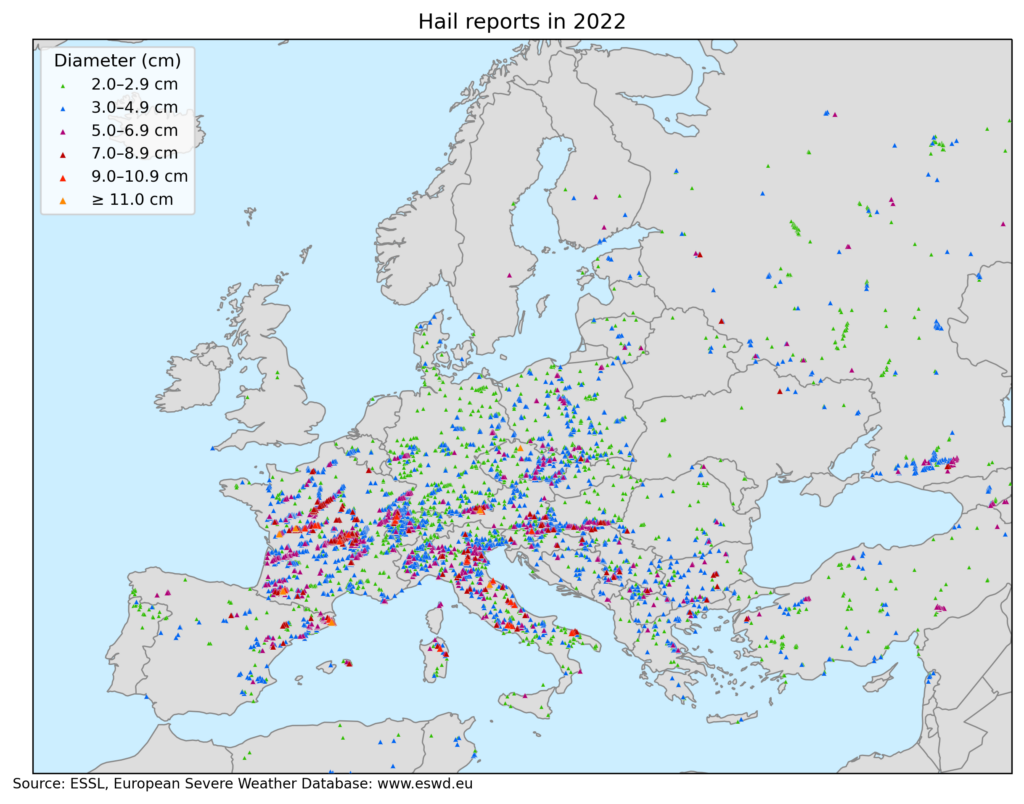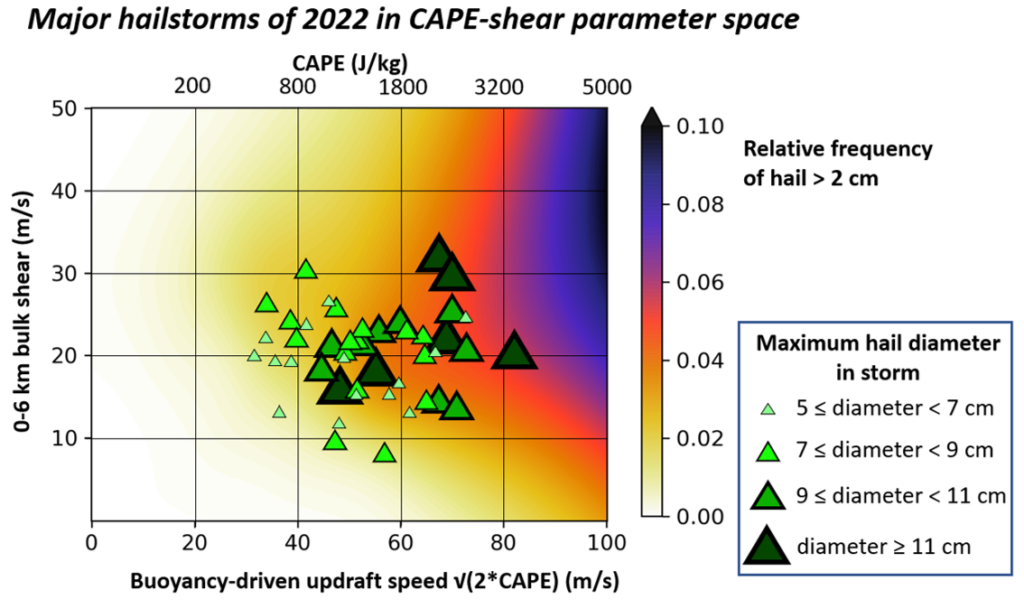The year 2022 was another record-breaking year for hailstorms in Europe. In total, 8224 large hail reports (≥ 2 cm in diameter) were submitted to ESWD. That is 2791 more than in 2021, which was already a record-breaking year. Very large hail (diameter ≥ 5 cm) was reported 1334 times and 18 reports involved giant hail with a diameter ≥ 10 cm. There were 213 days with at least one large hail and 94 days with at least one very large hail report. The period of 20 May to 10 July was particularly active concerning very large hail. Out of 52 days, very large hail was observed on 42 of them.

By far the largest number of reports was submitted for France (2461), followed by Italy (993) and Germany (583). The three days with the most hail reports were 4 June (411 reports), 20 June (385 reports), and 25 May (334 reports). Hail injured 215 people and killed 1. The two most societally impactful events were the Casamassima (Italy) hailstorm on 19 August with 100 injuries and the La Bisbal d’Empordà (Catalonia) hailstorm on 30 August with 67 injuries and one fatality. Hailstorms had a very large economic impact, especially in France, where the insured losses reached 4.8 billion € according to Swiss-Re. While some of the hailstorms produced large hail only for 15 minutes, some lasted for more than 3 hours. The longest-lasting hailstorm occurred on 22 May in France, producing large hail for 5 hours in a hail swath over 300 km long.
Major hail events of 2022 formed in a large range of CAPE and shear values. That said, the majority of the events occurred with CAPE exceeding 1000 J/kg and 0-6 km bulk shear exceeding 15 m/s, which is a parameter space where the large hail typically occurs. Some of the giant hail-producing events had a rather unremarkable environment. A good example of such a case is the hailstorm of 1 July over Czechia, which produced hail up to 11 cm in diameter with CAPE around 1000 J/kg and 0-6 km bulk shear well below 20 m/s. Giant hail was produced briefly following the merger of two storms. Hail around 3 cm in diameter was observed pre-merger and no large hail followed the brief period of giant hail production. This shows the importance of storm-scale processes, which can’t be captured by looking at the large-scale environment.

The biggest hailstorm cases of 2022:
20 May: Several hailstorms impacted northern France and western Germany. The largest hail, 8 cm across, fell in Sedan, France. Most hail damage was produced by a hailstorm that passed the northern suburbs of Koblenz, Germany, damaging roofs, windows, and cars. The largest hail reached 6 cm there.
22 May: A supercell tracked for more than 300 km across west-central France, impacting the towns of Niort, Poitiers, Chauvigny, and Chateauroux. Supercell produced hail for 5 hours with several peaks of activity, when the hail diameter exceeded 8 cm in diameter. The largest measured hail was 12 cm in diameter, but even larger may have fallen with reports of weight up to 780 g. Chateauroux was hard hit with hailstones up to 9 cm in diameter. 4 people were injured and the hail badly damaged 250 houses and 1000 cars.
Source: https://www.francebleu.fr/infos/faits-divers-justice/en-images-a-frontenay-rohan-rohan-des-grelons-comme-des-oranges-1653307396
25 May: Several supercells produced long hail swaths over southeastern Austria, Slovenia, northeastern Croatia, and Hungary. The largest hail measured 8 cm in diameter. Severe damage to buildings was reported in Kapela Podravska, Croatia, and Kiskorpád, Hungary.
28 May: South-moving hailstorm produced damage east of Milan. The largest hail reached 7 cm in diameter. A hail up to 8.5 cm in diameter was reported in the Smolan region, Bulgaria, damaging cars, roofs, and agriculture.
29 May: A woman was injured by very large hail in Italy. Hail up to 7.5 cm in diameter caused significant damage to roofs, cars, and greenhouses in Orizari, Bulgaria.
2 June: Severe hailstorms impacted southeastern Austria, Slovenia, and northern Croatia. Damage to crops, houses, and cars was reported. The maximum hail size reached “only” 5 cm, but hail fell in large quantities and was accompanied by severe winds in many locations with drifts up to 20 cm deep.
3 June: Hailstorms affected southern France. The largest hail measured 7.5 cm in diameter and the longest hailstreak was 150 km long.
4 June: Widespread hail damage was reported in central France, particularly in Vichy and surrounding areas. Hail reached up to 10 cm in diameter, severely damaging cars, roofs, and agriculture. 1 person was injured by hail in Vichy.
5 June: Hailstorms impacted eastern France, Switzerland, northwestern Italy, Slovenia, Austria, and Serbia. Hail up to 9.5 cm was reported in Frankolov, Slovenia, and an 11 cm hailstone fell in Kufstein, Austria.
19 June: A long-lived, right-moving supercell produced an almost 350 km long hail swath across France, affecting the outskirts of Orléans. The supercell produced hail for 4 hours. Roofs and cars were damaged along the path of the storm and the largest hail, measuring 8.5 cm, fell in Chambord and Saint Cyr en Val.
20 June: A long-tracked supercell crossed northern Bordeaux and destroyed more than 5000 hectares of agriculture with wind-driven hail in Dordogne. The largest hail diameter reached 7 cm. Serious damage to roofs and cars was reported in some parts of the hail swath. North of Pyrennees, a hailstorm produced giant hail with a maximum estimated hail size of 13 cm in Vic en Bigorre with widespread damage to roofs and cars. Long-lived supercells with hail also affected southern Germany and southeastern Czechia, but hail did not reach 5 cm.
21 June: Third day of severe hailstorms in France in a row. Wind-driven hail up to 9 cm in diameter impacts regions of Auvergne and Bourgogne, destroying agriculture, roofs, windows, and cars. House facades and sides of cars suffered extensive damage as the hail was blown horizontally in the strong wind. A video showing the combination of severe winds and very large hail can be found here. Another long-lived supercell produced hail up to 8 cm, severely damaging roofs and cars in the region of Morvan. Very large hail also fell in Italy, Slovenia and Serbia. In Serbia, hail up to 7 cm in diameter caused severe damage to agriculture and roofs in the Moravički region.
Christophe Asselin (Chroniques Chaotiques).
23 June: Hail and windstorm impacted Podgorica, Montenegro with damage to agriculture and cars. Largest hailstones reached 5.5 cm. Hail up to 8 cm in diameter was observed in Sfélinos, northern Greece.
26 June: Severe hailstorms affected eastern France with hail up to 7 cm in diameter. One of the storms also impacted Strassbourg and its outskirts and many cars were damaged.
27 June: Very large hail up to 8 cm in diameter was reported from southern Germany as two supercells tracked along the northern edge of the Alps. 7 cm hail was reported in western Czechia.
28 June: 1 person was injured by very large hail in Kastoriá, Greece.
29 June: Widespread large to very large hail was reported in eastern Czechia and southern Poland.
30 June: Very large hail fell in France, Italy, northern Czechia, Poland, and Bosnia-Herzegovina. The largest hail, 8.5 cm across, was reported in Blamont, France.
1 July: Giant hail up to 11 cm in diameter fell in Rovensko pod Troskami, Czechia. Very large hail also fell in eastern Czechia and western Slovakia from two long-lived supercells. Splitting supercells produced hail up to 6 cm in diameter in the Veneto region, Italy.
5 July: Severe hailstorm impacted southwestern Serbia. Hail up to 7 cm in diameter damaged crops, roofs and cars.
4 July: Very large hail up to 6 cm in diameter injured 2 in Castel Maggiore.
7 July: Several supercells formed in Veneto, Lombardia, and Emilia-Romagna regions in Italy, each producing very large hail. Widespread damage to cars, windows, and roofs was reported. The largest hail fell in Ostiglia and was estimated to be 9 cm in diameter.
20 July: Severe hailstorms occurred in Switzerland and eastern France. The most severe storm affected the region of Franche-Comté and the commune of Doubs, where hundreds of roofs, windows, and vehicles were badly damaged. The largest hailstone fell in Le Russey, estimated at 9 cm across.
27 July: Very large hail was reported from the Abruzzo province in Italy. The largest hail, 9 cm in diameter, fell in Teramo and Ascoli Piceno. Damage to cars, roofs, and windows occurred.
28 July: Left-moving supercell produced very large hail up to 8 cm in diameter near Lleida, Spain, damaging roofs, cars, windows, and greenhouses.
13 August: Southward moving supercell produced a long hail swath across Sardegna, a rather rare occurrence on the island. The largest hail was estimated to be 9 cm in diameter and fell in Alà dei Sardi.
17 August: Widespread large to very large hail was reported from southern France. The largest hail fell in Bonnétage, estimated at 8 cm across. In Catalonia, a woman was slightly injured by a 5 cm hailstone.
18 August: The event known especially for the powerful derecho producing wind gusts exceeding 60 m/s over Corsica also featured a number of damaging hailstorms. In the early morning hours, wind-driven hail injured 22 people in Sestri Levante and Lavagna in Liguria, Italy. Hail damaged cars, windows, and facades of houses. Around noon, a hailstorm struck Menorca with hail up to 7 cm in diameter. In the evening hours, another series of hailstorms impacted Italy, especially the regions of Marche and Tuscany. The largest hail, 11 cm in diameter, fell in Macerata Feltria damaging cars, and roofs and injuring 1 person.
19 August: Giant hail, reaching 10 cm in diameter, was reported from Casamassima, damaging cars, and windows. At least 100 people were lightly injured by hail. Most of the injuries were inflicted by broken glass. The number of injuries ranks as the third highest recorded in the ESWD for large hail events.
30 August: In the late afternoon, a supercell storm formed over the eastern Pyrenees. The storm moved southeastward and entered the district of Girona in Catalonia, producing a swath of very large hail (≥ 5 cm) between Esponnellá and Tamariu. Multiple reports of hailstones larger than 10 cm in diameter were collected with the largest stones estimated to be 12 cm. Impressive videos of the hailfall can be found here or here. Besides serious damage to roofs and cars, 67 injuries and even one fatality (a 2-month-old baby) resulted in the town of La Bisbal d’Empordà. 28 people had to be taken to the hospital, including one serious head injury. This was the first direct hail fatality in Europe since 1997. Furthermore, the number of injuries ranks as the fourth highest recorded in the ESWD for large hail events.
Source: https://mobile.twitter.com/Supercelulas
8 September: Southeastward moving supercell over Lazio, Italy produced a swath of very large hail. The largest hail, 9 cm across, fell in Boville Ernica.
27 September: Serious hail damage to roofs, cars, windows, and greenhouses was reported from Serbia, especially in Pomoravski okrug region. Hail reached up to 6 cm in diameter.
23 October: Intense storm that resulted in a long-tracked tornado in Haute-Normandie, northwestern France also produced very large hail up to 7.5 cm in diameter.
